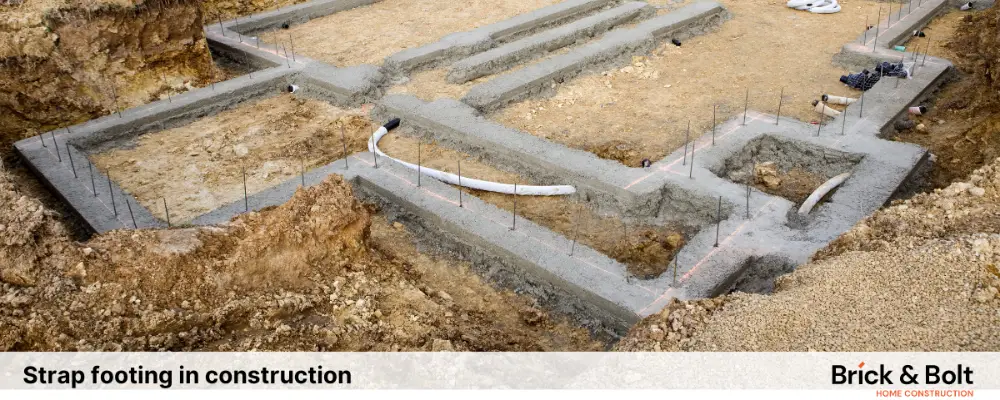Think about it: every time you’re building something, like a tall tower of blocks, it’s important that everything sets in place so it doesn’t fall over. Well, the builders must face the same challenges when constructing real buildings. One of the major components of making the building safe and strong is something called a “strap footing.” Let’s find out what strap footings are, why they’re important, and how they work.
What is a Strap Footing?
Imagine building a tall tower of blocks. To prevent it from falling over, you need to ensure that the blocks on the bottom are spread out evenly. Similarly, strap Footing in construction ensures the building stands tall and doesn’t fall over.
What is a Footing?
Before trying to understand what strap footings are, let’s briefly understand what a footing is. A footing in construction is a particular type of supporting base that supports the very foundation of a building. Think of it like the foundation of a table. If the table’s legs are not sitting evenly on the floor, the table might wobble. Likewise, the footing helps make the building’s foundation sit even on the ground for stability and strength.
What Makes Strap Footings Special?
A strap footing refers to a type of footing that helps an individual distribute the weight of an entire structure over a large area. This especially will come in handy in cases where the ground one has decided to build on is quite weak or unevenly set.
Now, imagine trying to stand on a soft, sandy beach. If you just stand on one small spot, you may sink into the sand. But if you spread out by lying down, you will stay on top of the sand. That’s kind of what strap footings do for a building; they help spread the weight so the building doesn’t sink or settle unevenly.
Parts of a Strap Footing
Strap footings are made up of several parts:
- Footing Slab: It’s a flat, thick layer of concrete slab that spreads out the weight of the building from the walls.
- Strap: This is a beam or thick strip of concrete that connects two or more footings together. It helps distribute weight between different areas.
- Foundation Walls: Sit on top of the footing and strap; they are the vertical pieces of the building that carry floors and the roof.
Why Use Strap Footings?
Here are some reasons why builders use strap footings:
- Weak Soil: When building on unstable ground, strap footings help distribute the weight over a larger area of a building. This reduces the chances of the building sinking into the ground.
- Uneven Ground: In cases of uneven ground, strap footings are used to hold the building steady since straps connect different parts of the footing for balanced weight distribution.
- Heavy Loads: For heavy buildings, such as large warehouses or high-rise apartments, strap footings share the weight evenly so that there is no structural collapse of the building.
How are Strap Footings Built?
Building a strap footing involves several steps:
- Planning: Planning is a step in the process whereby builders decide where footing and straps will sit. They use specific tools and plans to ensure everything is aligned just right.
- Excavation: This process involves digging into the ground in which the footing will come into place – digging a large hole in readiness for the base of the building.
- Setting Forms: Builders put wooden or metal forms into the holes. These forms mold the concrete as it is curing to shape.
- Reinforcement: These are steel bars or mesh set inside the forms. This will give the concrete added strength and prevent it from cracking.
- Pouring Concrete: A method in which concrete is poured into the forms. It is then allowed to cure for a few days. Just like you would let a cake cool down so you can take it out of the pan.
- Removing Forms: With the hardening of concrete, the forms are removed, giving the site solid footings and straps.
Benefits of Strap Footings
Strap footings are important for several reasons:
- Stability: They give buildings stability even on weak or uneven ground. It prevents the building from settling or tilting over time.
- Durability: Strap footings distribute the weight of a building over a wide area, reducing the possibility of cracks and other structural damages that may result from unequal weight distribution.
- Safety: While strap footing secures the building, it also keeps all the occupants of the building safe.
Examples of Where Strap Footings are Used
Strap footings are used in many types of buildings. Here are a few examples:
- Large Warehouses: These will carry heavy loads. Sometimes, the land where the warehouses are situated is not of total potency. The strap footings keep them firm and intact.
- High-Rise Buildings: High-rise buildings require highly strong footing structures if their weight is to be supported. Strap footings are useful in distributing the weight of a building evenly.
- Residential Homes: Strap footings are a very good solution to keep homes safe and strong in case the soil may not be strong or if the ground is uneven.
Conclusion
Strap footing supports usual building loads and distributes them in such a way as not to have concentrated binding forces. These types of footings, especially, will serve their purpose where lands contain weak or unevenly distributed soils and buildings that bear significant loads.

